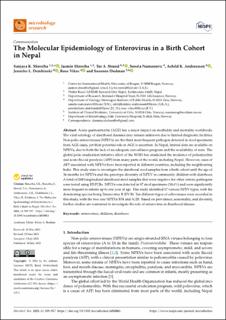| dc.contributor.author | Shrestha, Sanjaya K. | |
| dc.contributor.author | Shrestha, Jasmin | |
| dc.contributor.author | Strand, Tor A. | |
| dc.contributor.author | Numanovic, Sanela | |
| dc.contributor.author | Andreassen, Åshild Kristine | |
| dc.contributor.author | Dembinski, Jennifer Lynn | |
| dc.contributor.author | Vikse, Rose | |
| dc.contributor.author | Dudman, Susanne | |
| dc.date.accessioned | 2023-09-08T12:31:20Z | |
| dc.date.available | 2023-09-08T12:31:20Z | |
| dc.date.created | 2023-09-01T12:47:59Z | |
| dc.date.issued | 2023 | |
| dc.identifier.issn | 0944-5013 | |
| dc.identifier.uri | https://hdl.handle.net/11250/3088330 | |
| dc.description.abstract | Acute gastroenteritis (AGE) has a major impact on morbidity and mortality worldwide. The viral aetiology of diarrhoeal diseases may remain unknown due to limited diagnostic facilities. Non-polio enteroviruses (NPEVs) are the third most frequent pathogen detected in stool specimens from AGE cases, yet their potential role in AGE is uncertain. In Nepal, limited data are available on NPEVs, due to both the lack of an adequate surveillance program and the availability of tests. The global polio eradication initiative effort of the WHO has eradicated the incidence of poliomyelitis and acute flaccid paralysis (AFP) from many parts of the world, including Nepal. However, cases of AFP associated with NPEVs have been reported in different countries, including the neighbouring India. This study aims to investigate the diarrhoeal stool samples from a birth cohort until the age of 36 months for NPEVs and the genotype diversity of NPEV in community children with diarrhoea. A total of 280 longitudinal diarrhoeal stool samples that were negative for other enteric pathogens were tested using RT-PCRs. NPEVs was detected in 97 stool specimens (34.6%) and were significantly more frequent in infants up to one year of age. This study identified 17 various NPEV types, with the dominating species being Enterovirus B (EV-B). Ten different types of echoviruses were recorded in this study, with the two rare NPEVs B74 and A120. Based on prevalence, seasonality, and diversity, further studies are warranted to investigate the role of enterovirus in diarrhoeal disease. | en_US |
| dc.language.iso | eng | en_US |
| dc.publisher | MDPI | en_US |
| dc.rights | Navngivelse 4.0 Internasjonal | * |
| dc.rights.uri | http://creativecommons.org/licenses/by/4.0/deed.no | * |
| dc.title | The Molecular Epidemiology of Enterovirus in a Birth Cohort in Nepal | en_US |
| dc.type | Journal article | en_US |
| dc.type | Peer reviewed | en_US |
| dc.description.version | publishedVersion | en_US |
| dc.rights.holder | Copyright 2023 The Author(s) | en_US |
| cristin.ispublished | true | |
| cristin.fulltext | original | |
| cristin.qualitycode | 1 | |
| dc.identifier.doi | 10.3390/microbiolres14030063 | |
| dc.identifier.cristin | 2171670 | |
| dc.source.journal | Microbiology Research | en_US |
| dc.source.pagenumber | 909-917 | en_US |
| dc.identifier.citation | Microbiology Research. 2023, 14 (3), 909-917. | en_US |
| dc.source.volume | 14 | en_US |
| dc.source.issue | 3 | en_US |

